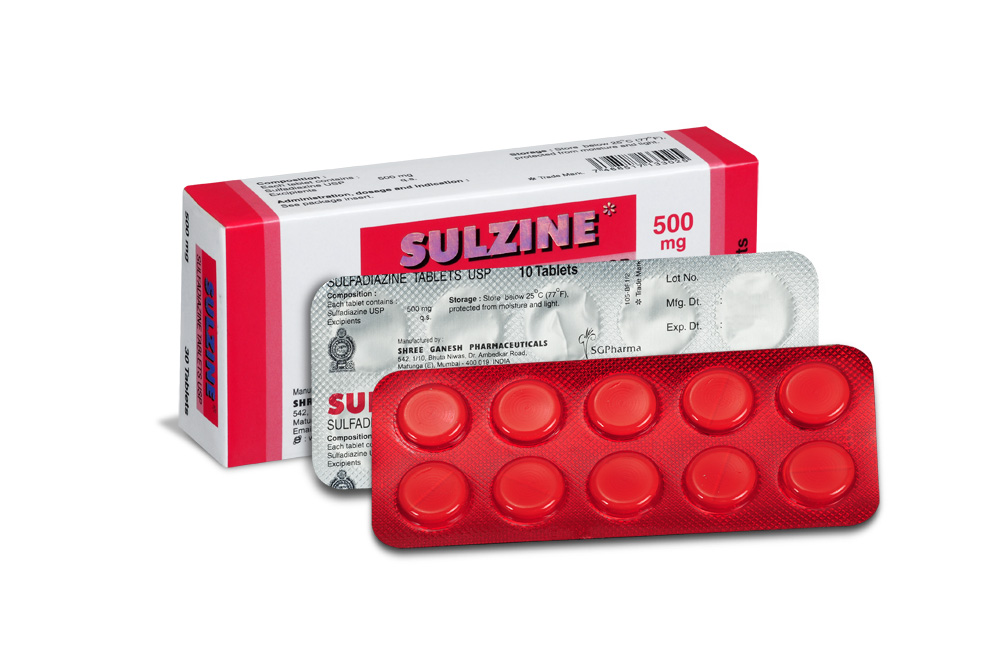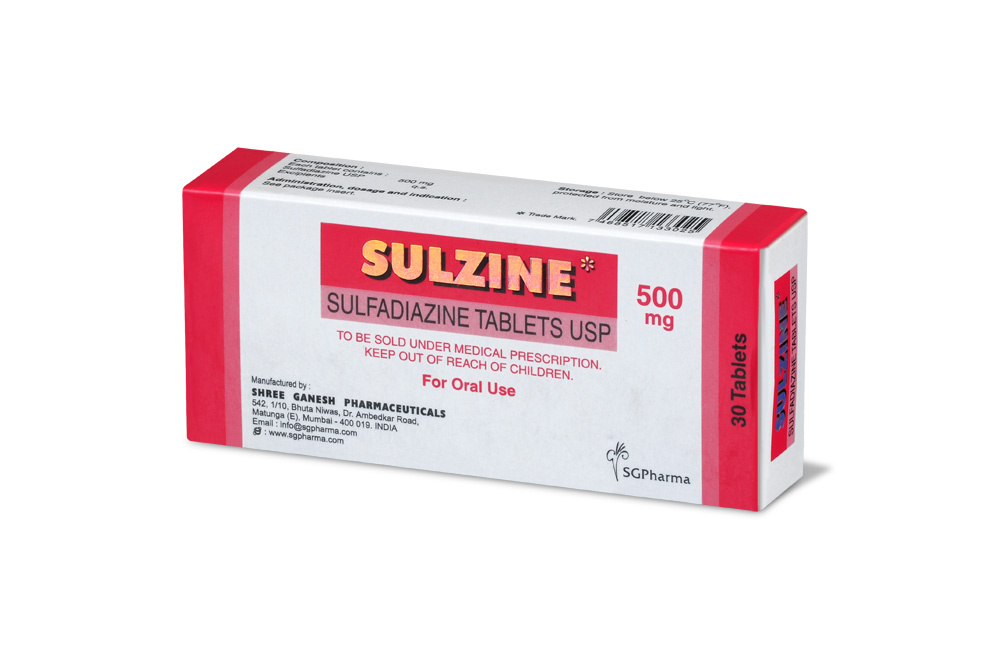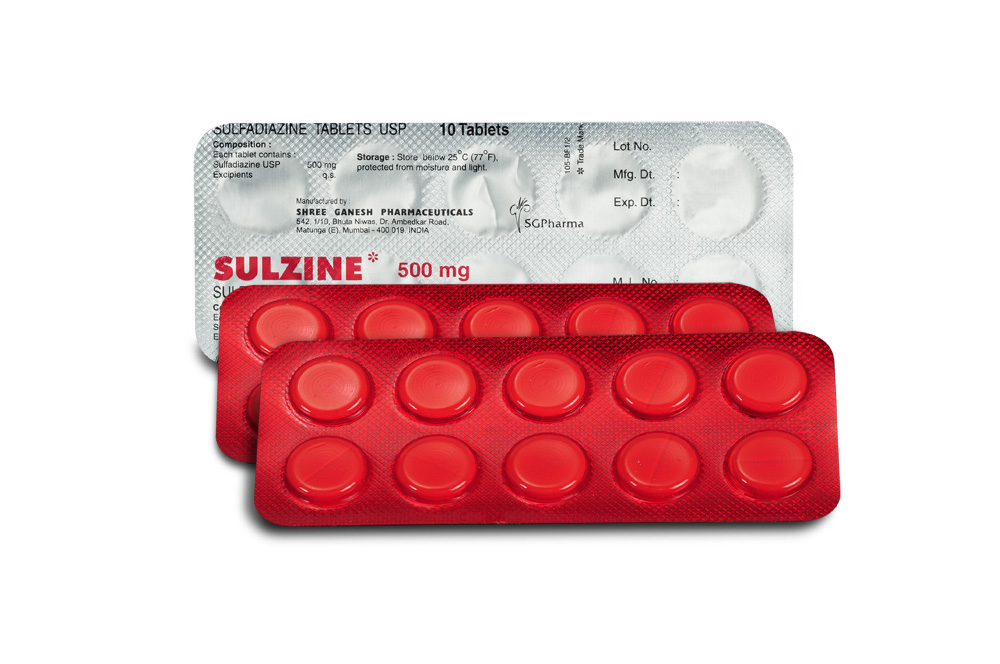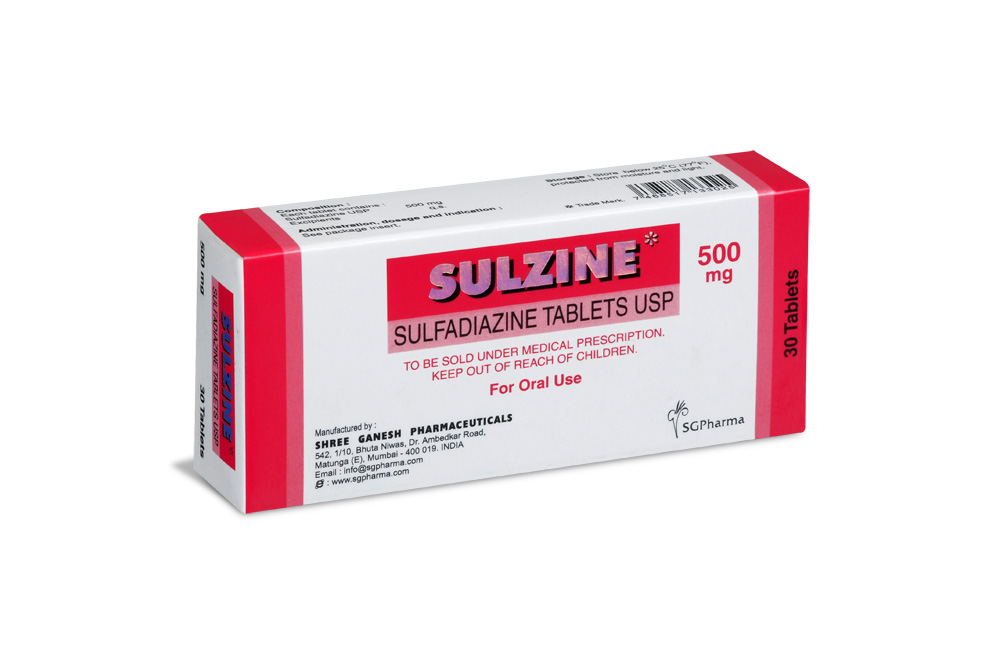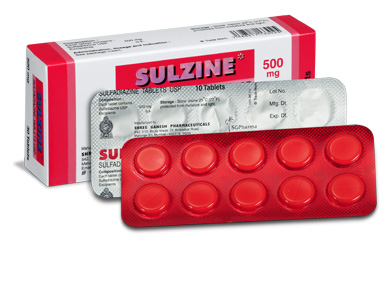
500 mg
For the use of a Registered Medical Practitioner or a Hospital or a Institution only.
SULZINE is one of the sulfa drug used to treat various infections. It belongs to the Sulfonamide group. Chemically, Sulfadiazine is N1-2-Pyrimidinylsulfanilamide. Molecular formula is C10H10N4O2S with molecular weight 250.28.
STRUCTURAL FORMULA :
Its structural formula is :
-Structure.jpg)
White, circular tablets with break line on one side.
COMPOSITION :
Each uncoated tablet contains :
Sulfadiazine USP 500 mg
Excipients q.s.
ACTIONS :
Sulfadiazine is a sulfonamide antibacterial that acts by blocking the conversion of paramino benzoic acid (PABA) to the co-enzyme dihydrofolic acid, a reduced form of folic acid necessary for synthesis of nucleic acids in sensitive organisms. Sulfadiazine has a bacteriostatic action on wide range of gram-negative and gram-positive micro-organisms.
PHARMACOKINETICS :
Sulfadiazine given orally is rapidly absorbed from the gastrointestinal tract, and peak blood concentrations are reached within 3 to 6 hours after a single dose. Following an oral dose of 3 g, peak concentrations in plasma are 50 mg/ml. About 55 % of the drug is bound to plasma protein at a concentration of 100 mg/ml when plasma protein levels are normal. Therapeutic concentrations are attained in cerebrospinal fluid within 4 hours after a single oral dose of 60 mg/kg. Sulfadiazine is excreted quite readily by the kidney in both the free and the acetylated form, rapidly at first and then more slowly over a period of 2 to 3 days. The half life of drug is 7 to 12 hours. It can be detected in the urine within 30 minutes after oral ingestion. About 15 % to 40 % of the excreted sulfadiazine is in the acetylated form. This form of the drug is excreted more readily than the free fraction, and the administration of alkali accelerates the renal clearance of both forms by further diminishing their tubular reabsorption.
INDICATIONS :
SULZINE is indicated in treatment of toxoplasmic encephalitis, a toxoplasmic infection of the brain, caused by reduction in T-4 cell count (T-lymphocyte) below 100 cells, in immunocompramised patients, especially people with HIV/AIDS. Sulfadiazine is sometimes used in combination with pyrimethamine & leucovorin as a maintenance therapy to prevent recurrence of toxoplasmosis in AIDS patients. SULZINE is indicated for the treatment of infection due to sulfonamide sensitive organisms. SULZINE is used to treat infections and is effective against various gram-negative & gram positive micro-organisms, including E. coli, Klebsiella, Enterobacter, Proteus mirablis, Proteus vulgaris, Staph. aureus, H. influenzae. It can also be used in prevention of rheumatic fever, chancroid, trachoma, urinary tract infections (pyelonephritis, cystitis), lymphogranuloma venereum, chlamydia trachomatic infections, inclusion conjunctivitis and nocardiosis, Malaria (adjunctive therapy).
SULZINE Tablets must be taken orally with plenty of water including several additional glasses of water throughout the day. SULZINE can be taken with or without food. Sulfadiazine is most commonly given in combination with pyrimethamine. The two drugs must be used together to achieve the greatest therapeutic effect. These drugs are used at relatively high doses, leading to a strong likelihood of side effects. The drugs can effectively cross the blood-brain barrier and thus are preferred to treat toxoplasmic encephalitis infections within the brain.
Chancroid, Inclusion conjunctivitis, Meningitis (H. influenza & meninogococcal), Trachoma, Urinary tract infections, Nocardiosis :
Adults :
2 - 4 grams initially followed by maintenance dose of 2 - 4 grams per day in 3 - 6 divided doses. Infants (< 2 months) : Use is not recommended.
Children 2 months of age and older :
75 mg/kg (34 mg/pound) of body weight initially followed by maintenance dose of 150 mg/kg/day in 4 - 6 divided doses (maximum of 6 grams per day).
Elderly :
There are no specific dosage recommendations for the elderly, but since sulfadiazine is contraindicated in the presence of mild renal failure, caution is advised in this age group.
Toxoplasmosis :
Treatment usually continues for at least 3 - 4 weeks. Much longer periods of treatment, as long as 6 months in some cases, may be required in people with HIV/AIDS. These drugs kill the form of the toxoplasma parasite that causes active disease, but do not kill the cystic form of the organism, which acts as a reservoir of infection within the human body. Relapse occurs in about half of all people who stop taking the drugs. For this reason it is extremely important to continue on maintenance therapy of some kind. For toxo, maintenance therapy is usually a slightly reduced dosage of the antibiotic treatments pyrimethamine and/or Bactrim. Infants (< 2 months) : 25 mg/kg/dose four times a day. Children 2 months of age & older : 25 - 50 mg/kg/dose four times a day.
CONTRAINDICATIONS :
Hypersensitivity to sulpha drugs, glucose-6-phosphate dehydrogenase (G6PD) deficiency, renal or hepatic disorders & acute porphyria. Contraindicated in infants under 2 months of age owing to the danger of Kernicterus, (except in congenital toxoplasmosis as an adjunct with pyrimethamine).
SPECIAL WARNINGS AND PRECAUTIONS FOR USE :
A high fluid intake (2.5 liters to 3.5 liters in 24 hrs) should be maintained and urinary output should not be less than half the amount. Patients taking this medicine should have regular blood tests. In addition the urine should be rendered alkaline.
Pregnancy category C :
There is epidemiological evidence of the safety of sulfadiazine in human pregnancy, but the clinician should assess the risk benefit factors before administering SULZINE Tablets to pregnant women. There is evidence of embryotoxicity and teratogenicity in animals at high dosage, especially during the first trimester. It is generally considered that sulfonamides should not be given in late pregnancy because of the risk of kernicterus in the newborn. However, recent work suggests that sulfadiazine may be used in late pregnancy with no ill effect on the newborn. Sulfonamides are excreted in the milk in small amounts and should be used with extreme caution in nursing mothers. It may cause liver problems, anaemia and other unwanted effects in nursing babies, especially those with glucose-6-phosphate dehydrogenase (G6PD) deficiency.
Those common to all sulfonamides may occur, including nausea, vomiting, diarrhoea, cyanosis, headache, depression and mental confusion. Haemolytic anaemia has been reported, especially in patients with glucose-6-phosphate dehydrogenase deficiency. Other blood dyscrasias include agranulocytosis, aplastic anaemia, leukopenia and thrombocytopenia. Hypersensitivity reactions such as erythema nodosum and drug rashes rarely occur. Other uncommon adverse effects include vasculitis like polyarteritis nodosa, Stevens-Johnson syndrome and anaphylaxis. Other side effects include hepatitis, jaundice, hepatic necrosis, interstitial nephritis, tubular necrosis, necrotising angiitis with hypersensitivity and crystalluria. If crystalluria followed by haematuria or oliguria occurs, sulfadiazine should be discontinued and large volumes of fluids administered (by intravenous infusion if necessary) followed by effective alkalinisation of the urine with sodium bicarbonate. Since AZT and the pyrimethamine/sulfadiazine combination both can cause neutropenia, regular monitoring for this side effect is important when using these drugs together.
- Consult your doctor/pharmacist if you are allergic to sulfadiazine, any other sulfa drugs, diuretic (“water pills”), oral diabetes medications, or any other drugs.
- Consult your doctor/pharmacist what prescription and nonprescription medications you are taking, especially anticoagulants (“blood thinners”) such as warfarin (Coumadin), diabetes medications, diuretics (“water pills”), and vitamins.
- Consult your doctor if you have or have ever had liver or kidney disease, asthma, severe allergies, or glucose-6-phosphate dehydrogenase (G-6PD) deficiency (an inherited blood disease).
- Plan to avoid unnecessary or prolonged exposure to sunlight and to wear protective clothing, sunglasses and sunscreen. Sulfadiazine may make your skin sensitive to sunlight.
OVERDOSAGE :
Symptoms of overdose may include loss of appetite, nausea, stomach cramps, dizziness, drowsiness, and loss of consciousness.
TREATMENT OF OVERDOSAGE :
Continuous forced fluids may be necessary and the urine should be rendered alkaline, otherwise treatment is symptomatic.
STORAGE :
Store below 30°C (86°F), protected from moisture and light.
SHELF LIFE :
24 months from date of manufacture.
PRESENTATION :
Sulzine Tablets contains Sulfadiazine USP 500 mg.
Box of 3 blisters of 10 Tablets.
Disclaimer : For the use of a Registered Medical Practitioner or a Hospital or a Institution only. Also it is not intended to be used by healthcare professionals or patients for the purpose of prescribing or administering these products. Questions regarding the complete and current content of product labeling / specification / presentation should be directed to SGPharma.

 Cardiovascular
Cardiovascular



